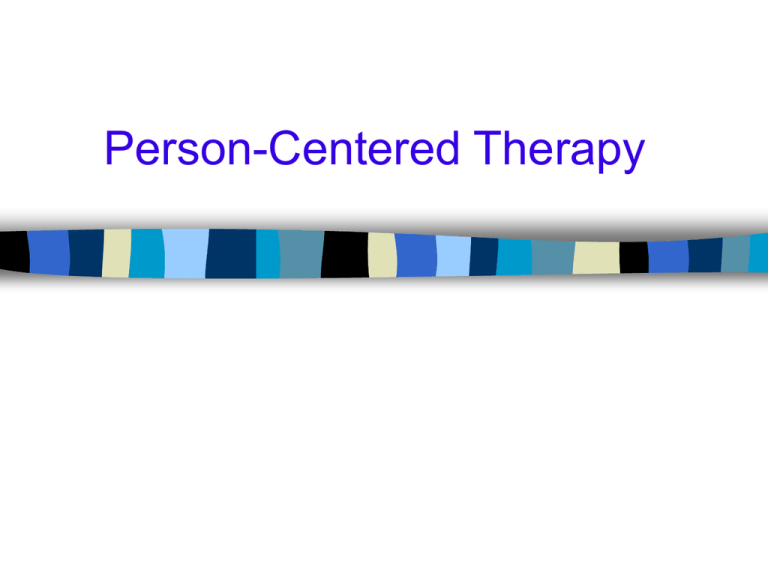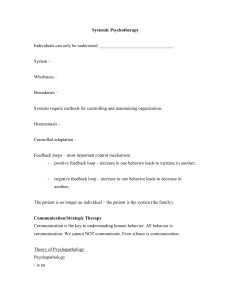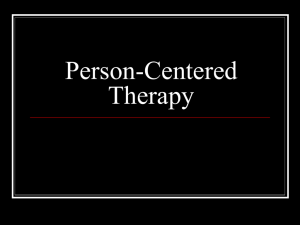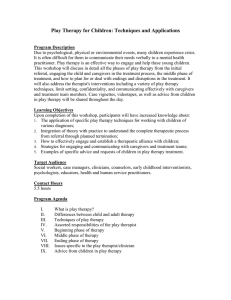Person-Centered Therapy
advertisement

Person-Centered Therapy P-C Therapy Challenges… Directive & Psychoanalytic Approaches An approach of offering advice, suggestion, diagnosis, and interpretation A belief that clients need direct help in order to resolve their own problems A focus on problems instead of persons P-C Therapy Emphasizes… Therapy is shared by C. and T. The client’s striving for self-actualization & capacity for growth The therapist’s personal characteristics The counselor’s creation of a “growth promoting” climate The quality of the therapeutic relationship Views of Human Nature Striving toward becoming fully functioning Having the inner resources Having self-healing capacities Being a primary change agent Actualizing self-potential Core concepts Empathy – Accurate understanding Congruence/genuineness – Therapist is his actual self in his encounter with his client Unconditional positive regard – Warmth, acceptance, nonjudgmental attitude Therapeutic Goals Goals are from the client, not the therapist an openness to experience A trust in themselves Acceptance of others Being less concerned about pleasing others Becoming a fully functioning person Therapist’s function to be present and accessible to clients to focus on immediate experience to be real in the relationship with clients Through the therapist’s genuine caring, respect, acceptance, and understanding, change becomes possible for clients Therapist’s Role Believe in the inner resources of the client (not in techniques) facilitating personal change Use of self Express feelings at the moment with the client Value the quality of the therapeutic relationship Is genuine, integrated, and authentic Serve as a model of a human being’s struggling Client’s Experience in Therapy Incongruence – discrepancy between self-perception and experience in realityanxietymotivation to help As clients feel understood and accepted – Less defensiveness – more open to their experiences Therapeutic relationship activate clients’ selfhealing capacities Relationship Between T and C Emphasizes the attitudes and personal characteristics of the therapist and the quality of therapeutic relationship. Therapist listening in an accepting way to their clients, they learn how to listen acceptingly to themselves. Relationship Between T and C Congruence – genuineness or realness Unconditional positive regards – acceptance and caring, but not approval of all behavior Accurate empathic understanding – an ability to deeply grasp the client’s subjective world Therapeutic techniques & procedures No techniques Not simply to restate what the client just said or the technique of reflection of feelings The therapeutic relationship is a key factor for growth Therapist’s presence – being completely engaged in the relationship with clients. The best source of knowledge about the client is the client Two Types of Research on P-C A. The importance of the Core Conditions (Genuineness, acceptance, and empathy) for Change 1. Barkhan & Shapiro (1986) 2. Bachelor (1988): four different client perceptions of empathy – Cognitive, affective, sharing, nurturant empathy 3. Client Evaluation of Counselor Scale (Hamilton, 2000): an instrument for clients’ perception of core conditions Two Types of Research on P-C B. Comparing the effectiveness of PersonCenter Therapy with other theories 1. 1960-1970: most P-C research in US; most recent research on P-C in Belgium and Germany 2. P-C Therapy is effective (Greenberg, Elliott, & Litaer, 1994) 3. But, CBT is more effective than P-C therapy for adults 4. Relaxation is more effective than P-C for anxiety ***Who benefits best from which types of therapy*** From a multicultural perspective Contributions – reached more than 30 counties and translated to 12 languages – Similarity b/w P-C and Eastern thoughts Limitations – Some may like structure, coping skills, directedness – Some may focus on family or societal expectations instead of internal evaluation – May be unfamiliar with people in different cultures Summary and Evaluation Contributions – Active role of responsibility of client – Inner and subjective experience – Relationship-centered – Focus on therapist’s attitudes – Focus on empathy, being present, and respecting the clients’ values – Value multicultural context Summary and Evaluation Limitations – Discount the significance of the past – Misunderstanding the basic concept: e.g., reflection feelings.









